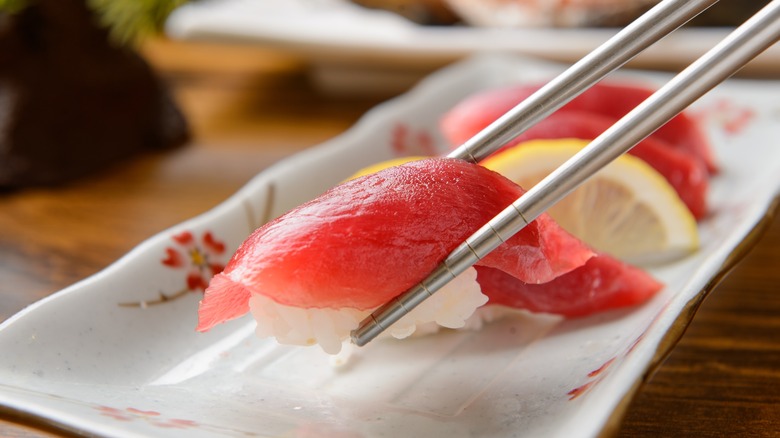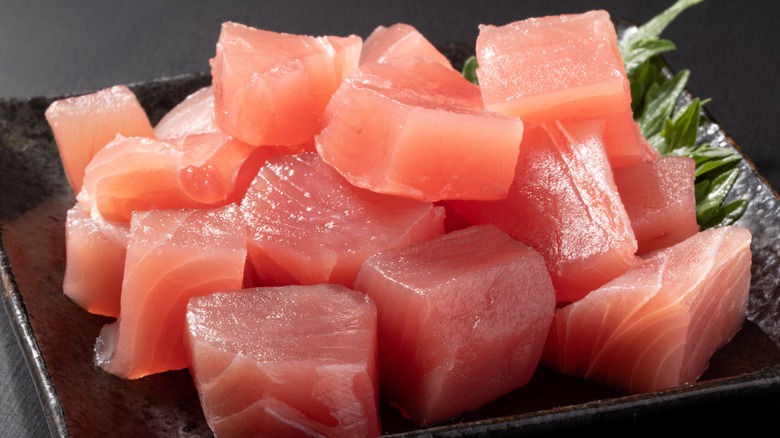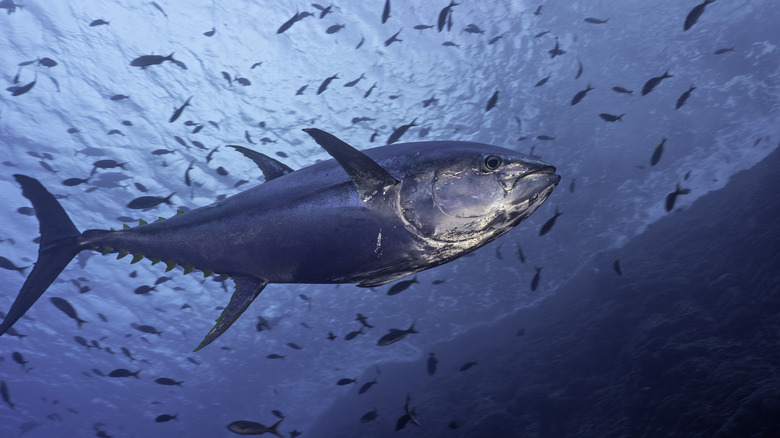Yellowfin Vs Bluefin Tuna: The Flavor Difference In Your Sushi
There's a lot you need to know if you're hoping to eat sushi like a pro. For example, you'll need to learn your different types of tuna. The term "tuna" refers to a fairly large family of fish that covers about 15 separate species. In the world of sushi, yellowfin and bluefin are the two most popular types of tuna, and their meat looks and tastes entirely different from one another.
Yellowfin is known as "kihada maguro" in Japan, and it's also commonly known by its Hawaiian name: Ahi tuna. It's mild in flavor and extremely lean, which it makes up for with a firm texture. "Maguro" can refer to any kind of tuna sushi or sashimi, but some sushi chefs use it only to describe bluefin. Bluefin is fattier than yellowfin with a much richer umami flavor, although it depends on its cut.
Interestingly, there's no blue or yellow in the tuna meat. Those English names come from the coloring of the skin and fins of the fish. Yellowfin have bright yellow finlets, a yellow lateral line, and a yellow dorsal fin; and bluefin are mostly blue and silver throughout the body with a dark blue tail.
Different cuts of tuna
There are three cuts of tuna that you'll see in Japanese restaurants. Akami is the leanest and the mildest-tasting cut, coming from the tuna's spine and back (known as its dorsal area — hence the term "dorsal fins"). Chutoro is a medium-fat cut from around the lower belly and tail, and Otoro is an extremely rich fatty cut from the upper belly. Most maguro that you'll eat is the less fatty Akami, while Otoro tends to be pricier and more highly prized.
Bluefin is used almost exclusively in sashimi because of its bold, rich taste, while yellowfin is versatile enough to be used in nigiri sushi and other dishes. The best canned tuna brands also frequently feature yellowfin.
Despite their similar names, yellowfin tuna shouldn't be confused with yellowtail fish (also called amberjack), which isn't a tuna. Yellowfish is used for "hamachi" sushi and is pale white with a sweet, buttery taste. Try not to mix up all these fish with colors in their names — they're entirely different species.
Choosing between yellowfin and bluefin
When you're thinking about foods to avoid ordering at a sushi restaurant, you may be thinking of heavier foods like Philadelphia rolls with their thick cream cheese. But it's bluefin tuna that may not be the best choice. Many environmental groups, such as the Monterey Bay Aquarium Seafood Watch, warn against fishermen catching bluefins in their trolling lines because the fish population has steeply declined in recent years due to overfishing. The World Wildlife Fund even considers bluefins to be endangered. Still, these boycotts face setbacks because bluefin tuna is considered a luxury due to its rich taste, and sushi restaurants are willing to pay lots of money to get some.
In contrast, populations of yellowfin tuna are much healthier and are currently considered a more sustainable choice for seafood. Besides simple kihada nigiri, where yellowfin is served over vinegared sticky rice, it's also a great choice for spicy tuna rolls. Its milder taste blends well with the sriracha that gives the roll its kick. It works well as a protein in avocado rolls, too.
Due to being more readily available to fishermen, yellowfin is more affordable than bluefin and often easy to find at sushi restaurants. So unless you're a big spender, yellowfin is probably what you'll be enjoying during your meal.


